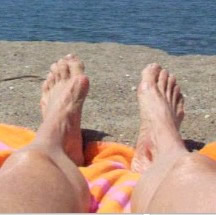 You should be relaxed and resting on your laurels after a long day on skates, especially if you managed to avoid getting blistered or bruised feet (see my review of eZeefit ankle booties for those complaints). But for some, tired or crampy feet or lower legs can be painful or distracting enough to ruin that well-deserved lounge time.
You should be relaxed and resting on your laurels after a long day on skates, especially if you managed to avoid getting blistered or bruised feet (see my review of eZeefit ankle booties for those complaints). But for some, tired or crampy feet or lower legs can be painful or distracting enough to ruin that well-deserved lounge time.
Listed in short- to long-term order, here are some tips to treat the most common foot-related after-affects of a long roll, and perhaps even head them off in the future.
Dehydration – Drink plenty of water daily, sip often during your long roll, and chug extra fluids the remainder of the day. Consider using a sports drink during the activity to preserve or replace essential minerals lost through sweat.
Aching fatigue – Immediately after removing your skates, use 10-15 minutes of stretching to squeeze lactic acid out of hard-worked tissues. This helps head off some of the other symptoms and also restores elasticity lost during the repetitive motions and postures of skating.
Tight foot muscles – Keep a tennis ball in your skate bag. As soon as you finish stretching, stand up and wedge it under one foot. Bear weight to a tolerable pressure to press under your toes, then the ball, arch, and heel. After several seconds, your foot will begin to relax and spread out over the ball. You’ll feel the proof if you stand on both feet before stretching your second foot over the ball.
Lactic acid buildup – Lucky are those who have access to the magic hands of a massage therapist! Lacking that, plan on doing your own foot and lower leg massage. Use massage oil if you prefer, or slippery soap while soaking in a hot bath. You can also use the strong jet of a Jacuzzi if that’s available.
Calf and foot cramping – Regardless of how much you drink, do you still experience Charlie Horses or twitchy calves after a long skate? Boy, I sure do! After years of suffering and trying the above tricks, I learned that when Quinine supplements were used to treat malaria in workers building the Panama Canal, those getting quinine also quit having leg cramps. Eureka! Besides the Tea and Tonic recipe I use, other cramp-reduction remedies include taking iron, potassium, calcium, and/or magnesium supplements and, for those who can stomach it, drinking flat Coca Cola during the activity.
Tight ankles – You may not even know you have them! High-cuff inline skates restrict your range of motion at the ankle. The chance of leg cramps is high after exertion. In off-skates time, you can counteract ankle tightness by using “floppy foot” exercises to retrain your ankles. The easiest way is to sit on edge of a chair or your bed with one leg crossed at the knee. Kick the dangling foot up and down and let it flop loosely in whatever direction you shake it. (It’s OK to use your hands). To add resistance, sit on the side of a swimming pool and kick the water until you can feel successful flopping. The goal is to train your legs’ neuromuscular patters so that the slightest kick from the knee will cause a flop.
Muscular imbalance – Skating and many other sports strengthen the back calf muscles more than the front ones. There are not so many ways to gain corresponding strength in the front shin muscles. An easy and enjoyable way to build shin strength is to walk down a steep hill twice a week; of course you must also walk up.
Quench your thirst and treat your feet: That’s how to take care of tuckered tootsies after they’ve had a long, hard day.
Tea and Tonic Iced Tea
Here’s my favorite (zero-calorie!) beverage. Makes 2 servings
Let steep for 45 minutes to an hour:
– 12 oz. of plain, cold water
– 2 fruity (non caffeinated) tea bags of your choice
To serve, combine:
– 6 oz cold tea
– 6 oz Diet Tonic water (I prefer the flavor of Schweppes) *
– Garnish with lemon (optional)
– Ice cubes (optional)
* Diet Tonic water is sweetened with Saccharin, which despite bad press during the launch of Aspartame, has never been scientifically proven to cause cancer in lab rats. Further research revealed that Aspartame is considered the most dangerous of artificial sweeteners! That’s why Stevia is a mainstay at our house.
Tags: achy feet, dehydration, fitness, skating workouts